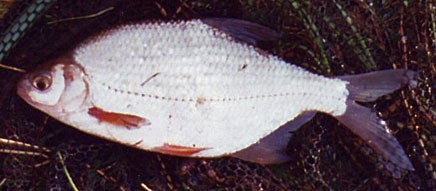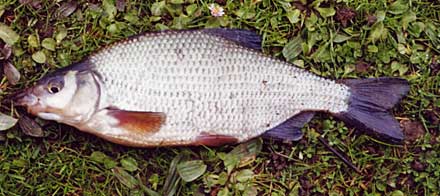| MARK WINTLE |
| Mark Wintle, an angler for thirty-five years, is on a quest to discover and bring to you the magic of fishing. Previously heavily involved with match fishing he now fishes for the sheer fun of it. With an open and enquiring mind, each week Mark will bring to you articles on fishing different rivers, different methods and what makes rivers, and occasionally stillwaters, tick. Add to this a mixed bag of articles on catching big fish, tackle design, angling politics and a few surprises. Are you stuck in a rut fishing the same swim every week? Do you dare to try something different and see a whole new world of angling open up? Yes? Then read Mark Wintle’s regular weekly column. |
| THE INVISIBLE SILVER BREAM In this vastly technical world of ours, evolution has finally produced a completely invisible fish. To actually see this fish you have to take the blinkers off and accept that it does exist in British freshwater by the million. What fish am I talking about?
The utterly ignored silver bream. A hundred years ago, anglers had little trouble recognising it for what it was, though the roach x bream hybrid was often described as Pomeranian bream (even given a Latin name). In those days, a much higher proportion of coarse fishing was done on rivers with ‘roach’ tackle and the likelihood of encountering ‘silvers’ was much greater. But ignorance of silver bream seems to be spreading. I rarely see mention of this species though I am sure that it continues to get caught in good numbers on those waters where it thrives. What you do see, is mention of ‘hybrids’ or skimmers, especially on reports from the Trent and Bristol Avon. Sometimes this is really the case but more often, the anglers are really catching silver bream. The original distribution of silver bream was much the same as barbel, ie, those eastern flowing rivers of England that once drained into the greater Rhine system. This means rivers like the Thames, Trent/Yorkshire river system and the rivers of Fenland such as the Great Ouse, Nene, Witham and Welland. But over the centuries, fish transfers for restocking enabled silver bream to become established in rivers like the Bristol Avon and Dorset Stour. Links via our canal network must have also enabled silver bream to become more widespread. Those on the Stour are my most local fish, and were stocked back in 1912 from the Thames into the tidal reaches. At one time, they got up into the Royalty Fishery on the Avon but seem to have vanished in the last few decades. I’ve never encountered silver bream on the Stour above Throop Mill, and this would appear to be their limit. They like slow flowing water with plenty of weed beds, and I have encountered them on canals and lakes. No one actually knows how big they might grow to, though the consensus is that about two pounds is their upper limit. My own best is three fish each of exactly one pound though the biggest one I have seen is 1-12 from the Bristol Avon. As we are talking about a shoal fish, where they are found they usually occur in good numbers, often mixed in with shoals of roach. When I have caught them on gravel pits, the shoals have been huge. Ringwood’s Half Pit, better known in recent times for huge tench, used to teem with them, and I’ve had up to three hundred in a match (for a staggering eighteen pounds). Some of the other pits in the vicinity also had them in abundance, but they seem to have long disappeared. One of the most informative articles I have seen on silver bream was written nearly thirty years ago by the late David Carl Forbes in Anglers Mail. Luckily, I cut it out at the time and kept it. What David Carl Forbes did was realise that when it came to identifying silver bream most of the textbooks were wrong! He saw that the scale counts given for the lateral line simply had much too great a range for them to possibly be true. One example had a range of 43 to 55, yet when he did some checking of his own, and like me he had little difficulty recognising silver bream, he found that the range did not vary from 44 to 47. This suggests that the textbooks were including all manner of other fish in their sampling including small common bream and roach x bream hybrids. The bronze bream appears to never have less than 50 scales and more usually 52 to 54 scales along the lateral line. So, the first important recognition point for a silver bream is comparatively large scales compared to a common bream skimmer of the same size. David Carl Forbes’ view was that his figures were actually more reliable than the textbooks. His logic was that such a huge variation in scale counts is highly improbable.
The second feature of silver bream is that the eye is slightly larger than that of the common bream, and more importantly, it is set closer to the snout. In DCF’s view, the width of the eye is about the same as the distance of the edge of the eye from the tip of the snout. The shape of the silver bream is also different; they are slightly fatter than a common bream of the same size yet deeper than a roach x bream. The small bream has a diamond shape yet the silver bream has a more rounded shape. These are subtle differences so it is hardly surprising that anglers catching silver bream can recognise that what they are catching is not a skimmer, but given the similarities with a roach x bream hybrid call them hybrids. The roach x bream hybrid might well have a lateral line scale count that falls within the range for silver bream but the fin ray count for the anal fin is likely to be less than the 20+ of a silver bream or common bream.
For me though, the worst fish to try and identify are the rare but definitely out there hybrids involving silver bream. To my regret, I did not photograph the rudd x silver bream I caught last year. Probably slightly more common, and definitely hard to spot, are silver bream x common bream and silver bream x roach.
Does all of this matter? To most anglers probably not, yet if we are to have a true silver bream as a record then it is important. Given the possibilities described above, a DNA test is vital. Another group of anglers that need to know are match anglers that target them on rivers like the Trent. They may not win many matches but silver bream can be important makeweights in team events. As silver bream have their own distinctive feeding patterns and preferences, match anglers that understand them have an advantage when it comes to catching them. Roach x bream behave differently and are more likely to be caught on lakes. At least three of our top match anglers have written about silver bream (Alan Scotthorne, Tom Pickering and Kim Milsom) not forgetting some of Jan Porter’s articles. The final category for needing to know is those restocking their waters. If you can’t tell the difference between silver bream and common bream what happens if you get a load of silver bream by mistake? Perhaps now you’ve seen what one looks like you will be able to spot a silver bream when you see one! |

















